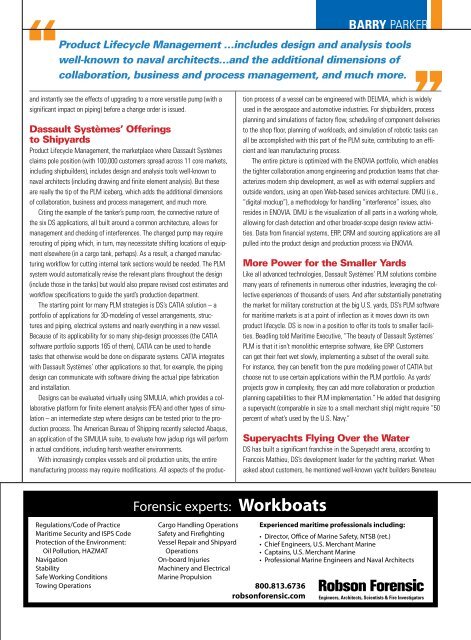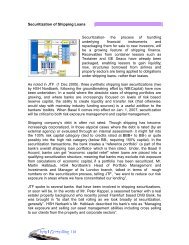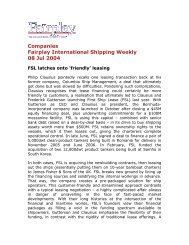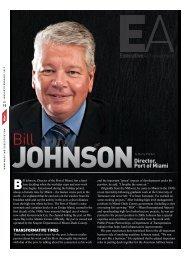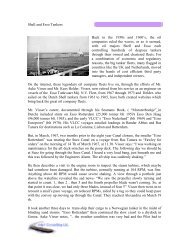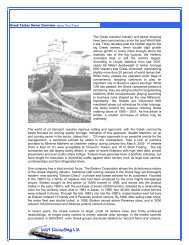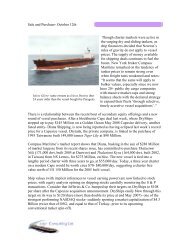Joseph S. Compofelice
Joseph S. Compofelice
Joseph S. Compofelice
Create successful ePaper yourself
Turn your PDF publications into a flip-book with our unique Google optimized e-Paper software.
arry parker<br />
Product Lifecycle Management …includes design and analysis tools<br />
well-known to naval architects…and the additional dimensions of<br />
collaboration, business and process management, and much more.<br />
and instantly see the effects of upgrading to a more versatile pump (with a<br />
significant impact on piping) before a change order is issued.<br />
Dassault Systèmes’ Offerings<br />
to Shipyards<br />
Product Lifecycle Management, the marketplace where Dassault Systèmes<br />
claims pole position (with 100,000 customers spread across 11 core markets,<br />
including shipbuilders), includes design and analysis tools well-known to<br />
naval architects (including drawing and finite element analysis). But these<br />
are really the tip of the PLM iceberg, which adds the additional dimensions<br />
of collaboration, business and process management, and much more.<br />
Citing the example of the tanker’s pump room, the connective nature of<br />
the six DS applications, all built around a common architecture, allows for<br />
management and checking of interferences. The changed pump may require<br />
rerouting of piping which, in turn, may necessitate shifting locations of equipment<br />
elsewhere (in a cargo tank, perhaps). As a result, a changed manufacturing<br />
workflow for cutting internal tank sections would be needed. The PLM<br />
system would automatically revise the relevant plans throughout the design<br />
(include those in the tanks) but would also prepare revised cost estimates and<br />
workflow specifications to guide the yard’s production department.<br />
The starting point for many PLM strategies is DS’s CATIA solution – a<br />
portfolio of applications for 3D-modeling of vessel arrangements, structures<br />
and piping, electrical systems and nearly everything in a new vessel.<br />
Because of its applicability for so many ship-design processes (the CATIA<br />
software portfolio supports 165 of them), CATIA can be used to handle<br />
tasks that otherwise would be done on disparate systems. CATIA integrates<br />
with Dassault Systèmes’ other applications so that, for example, the piping<br />
design can communicate with software driving the actual pipe fabrication<br />
and installation.<br />
Designs can be evaluated virtually using SIMULIA, which provides a collaborative<br />
platform for finite element analysis (FEA) and other types of simulation<br />
– an intermediate step where designs can be tested prior to the production<br />
process. The American Bureau of Shipping recently selected Abaqus,<br />
an application of the SIMULIA suite, to evaluate how jackup rigs will perform<br />
in actual conditions, including harsh weather environments.<br />
With increasingly complex vessels and oil production units, the entire<br />
manufacturing process may require modifications. All aspects of the production<br />
process of a vessel can be engineered with DELMIA, which is widely<br />
used in the aerospace and automotive industries. For shipbuilders, process<br />
planning and simulations of factory flow, scheduling of component deliveries<br />
to the shop floor, planning of workloads, and simulation of robotic tasks can<br />
all be accomplished with this part of the PLM suite, contributing to an efficient<br />
and lean manufacturing process.<br />
The entire picture is optimized with the ENOVIA portfolio, which enables<br />
the tighter collaboration among engineering and production teams that characterizes<br />
modern ship development, as well as with external suppliers and<br />
outside vendors, using an open Web-based services architecture. DMU (i.e.,<br />
“digital mockup”), a methodology for handling “interference” issues, also<br />
resides in ENOVIA. DMU is the visualization of all parts in a working whole,<br />
allowing for clash detection and other broader-scope design review activities.<br />
Data from financial systems, ERP, CRM and sourcing applications are all<br />
pulled into the product design and production process via ENOVIA.<br />
More Power for the Smaller Yards<br />
Like all advanced technologies, Dassault Systèmes’ PLM solutions combine<br />
many years of refinements in numerous other industries, leveraging the collective<br />
experiences of thousands of users. And after substantially penetrating<br />
the market for military construction at the big U.S. yards, DS’s PLM software<br />
for maritime markets is at a point of inflection as it moves down its own<br />
product lifecycle. DS is now in a position to offer its tools to smaller facilities.<br />
Beadling told Maritime Executive, “The beauty of Dassault Systèmes’<br />
PLM is that it isn’t monolithic enterprise software, like ERP. Customers<br />
can get their feet wet slowly, implementing a subset of the overall suite.<br />
For instance, they can benefit from the pure modeling power of CATIA but<br />
choose not to use certain applications within the PLM portfolio. As yards’<br />
projects grow in complexity, they can add more collaboration or production<br />
planning capabilities to their PLM implementation.” He added that designing<br />
a superyacht (comparable in size to a small merchant ship) might require “50<br />
percent of what’s used by the U.S. Navy.”<br />
Superyachts Flying Over the Water<br />
DS has built a significant franchise in the Superyacht arena, according to<br />
Francois Mathieu, DS’s development leader for the yachting market. When<br />
asked about customers, he mentioned well-known yacht builders Beneteau<br />
Forensic experts: Workboats<br />
Regulations/Code of Practice<br />
Maritime Security and ISPS Code<br />
Protection of the Environment:<br />
Oil Pollution, HAZMAT<br />
Navigation<br />
Stability<br />
Safe Working Conditions<br />
Towing Operations<br />
Cargo Handling Operations<br />
Safety and Firefighting<br />
Vessel Repair and Shipyard<br />
Operations<br />
On-board Injuries<br />
Machinery and Electrical<br />
Marine Propulsion<br />
Experienced maritime professionals including:<br />
• Director, Office of Marine Safety, NTSB (ret.)<br />
• Chief Engineers, U.S. Merchant Marine<br />
• Captains, U.S. Merchant Marine<br />
• Professional Marine Engineers and Naval Architects<br />
800.813.6736<br />
robsonforensic.com<br />
Engineers, Architects, Scientists & Fire Investigators<br />
NOVEMBER/DECEMBER 2008 | 61


